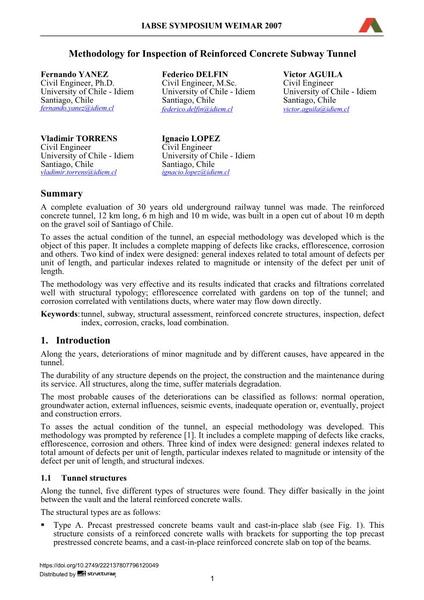Methodology for Inspection of Reinforced Concrete Subway Tunnel

|
|
|||||||||||
Bibliografische Angaben
| Autor(en): |
Fernando Yanez
Federico Delfin Victor Aguila Vladimir Torrens Ignacio Lopez |
||||
|---|---|---|---|---|---|
| Medium: | Tagungsbeitrag | ||||
| Sprache(n): | Englisch | ||||
| Tagung: | IABSE Symposium: Improving Infrastructure Worldwide, Weimar, Germany, 19-21 September 2007 | ||||
| Veröffentlicht in: | IABSE Symposium Weimar 2007 | ||||
|
|||||
| Seite(n): | 152-153 | ||||
| Anzahl der Seiten (im PDF): | 8 | ||||
| Jahr: | 2007 | ||||
| DOI: | 10.2749/222137807796120049 | ||||
| Abstrakt: |
A complete evaluation of 30 years old underground railway tunnel was made. The reinforced concrete tunnel, 12 km long, 6 m high and 10 m wide, was built in a open cut of about 10 m depth on the gravel soil of Santiago of Chile. To asses the actual condition of the tunnel, an especial methodology was developed which is the object of this paper. It includes a complete mapping of defects like cracks, efflorescence, corrosion and others. Two kind of index were designed: general indexes related to total amount of defects per unit of length, and particular indexes related to magnitude or intensity of the defect per unit of length. The methodology was very effective and its results indicated that cracks and filtrations correlated well with structural typology; efflorescence correlated with gardens on top of the tunnel; and corrosion correlated with ventilations ducts, where water may flow down directly. |
||||
| Stichwörter: |
Risse Korrosion Bauwerksprüfung Stahlbetonbauwerk Lastkombination Tunnel
|
||||

